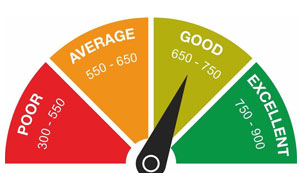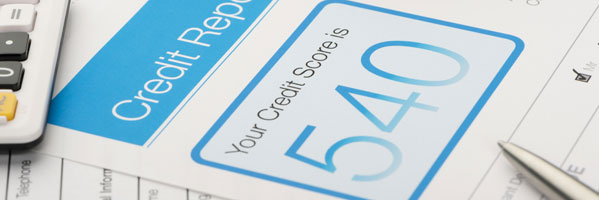Good Credit Score – When it Comes to Real Estate
Good Credit
What is ‘Good’ Credit in Real Estate?
In the real estate world, most experts agree that if your FICO score is at least 740, you’ll be eligible for the best interest rates that are offered at the time. However, for every 20 points your credit score comes in below this 740 threshold, you’re likely to have add-ons to the interest rate – and you may not be eligible for certain programs. So say, for instance, that you have a 740 credit score and you lock in a 4.125 percent interest rate on your mortgage loan. If your score came in at 700, your rate might be 4.5 percent, at 660 it might be 5 percent and so on.
The experts also agree that too low a credit score will result in either very high interest rates or in complete denial of your mortgage application. Generally speaking, this low range where things can become somewhat sticky is between 600 and 620.
In saying all of this, it is worth noting that whether a mortgage application is approved or denied, as well as the interest rate, is largely dependent on the lender that you’re working with. For instance, some lenders may be more flexible with low credit scores than others.
What if I Have Poor Real Estate Credit?
If you’re in the 600-620 gray area and are either unsure of whether your mortgage application will be approved or if you can afford a higher interest rate if it is approved, your best option is to work to repair your credit to make you a more attractive consumer in the future. Here are some tips and suggestions in doing so:
- Make sure you pay all of your bills on time. This is one of the largest weighed factors in determining your credit score.
- Concentrate on paying down high-interest debt.
- Check your credit report to ensure that it is error-free. (It’s estimated that the majority of credit reports have some sort of error on them.)
- Ensure that your debts owed is at or less than 30 percent of your total credit allotment.
- Only take out new lines of credit when necessary.
New Credit Scoring Models Won’t Work if Lenders Ignore Them
Chances are you’ve already heard some of the rumblings regarding the way new credit scoring models work. To recap, some of the newer models exclude any medical debt that consumers owe as well as the likes of settled delinquencies and collections. Under new scoring models, tax liens and civil judgments have also changed in the ways they are reported – all for the betterment of consumers. In a perfect world, this is great news for the consumer, as individuals are likely to see a boost in their credit scores and qualify for lower interest rates on long-term financed purchases like auto and mortgage loans. As a result of these changes, credit score boosts may be enough to qualify consumers that otherwise wouldn’t have even qualified for a loan. But there’s one problem – lenders aren’t embracing them to the same degree that consumers are. In fact, some are using old formulas to determine consumer risk that don’t exclude everything that we listed above.
Chances are you’ve already heard some of the rumblings regarding the way new credit scoring models work. To recap, some of the newer models exclude any medical debt that consumers owe as well as the likes of settled delinquencies and collections. Under new scoring models, tax liens and civil judgments have also changed in the ways they are reported – all for the betterment of consumers. In a perfect world, this is great news for the consumer, as individuals are likely to see a boost in their credit scores and qualify for lower interest rates on long-term financed purchases like auto and mortgage loans.
New Credit Scoring Models Won’t Work if Lenders Ignore Them. New Credit Scoring Models Won’t Work if Lenders Ignore Them”
As a result of these changes, credit score boosts may be enough to qualify consumers that otherwise wouldn’t have even qualified for a loan.
But there’s one problem – lenders aren’t embracing them to the same degree that consumers are. In fact, some are using old formulas to determine consumer risk that don’t exclude everything that we listed above.
Why Aren’t Lenders Using New Scoring Models?
So just why aren’t the majority of lenders using the new scoring models and instead relying on old FICO scoring formulas? That’s a good question, and it’s one where the answer varies based on the lender. For instance, some lenders have stated that they’re too small and the older formulas are a better indication of potential consumer risk. Other lenders, conversely, say that they’re too big to institute changes in how they determine consumer risk and that any change this significant could be disruptive to the way that they do business. Then there are the lenders who are just simply putting off integrating such formulas.
Whatever the reason, the true loser is the consumer in all of this. In a way, lender refusal to use new credit scoring formulas discourages responsible credit behavior. Think about it: Why should a consumer be motivated to pay off a collection if a settled collection is still going to be counted against them on their credit report and credit score? The refusal of lenders to adapt to the current times and the newer scoring models could actually prevent consumers from enacting credit repair strategies.
Taking things a step further, the lender would also benefit by adopting these new scoring formulas. That’s because weighing consumers under the new scoring formulas would likely earn them new customers that may not have qualified for a loan before. New customers and more customers equal more revenue for a firm. Isn’t growing to become more profitable the goal of any business, big or small? Credit scoring is changing to become more consumer-friendly. Lenders need to be changing too. It should be a win-win for both parties involved.
FICO Introduces New Credit Scoring Model

However, this could soon be changing thanks to a new FICO score – FICO Score XD – that’s designed for consumers that may not have a traditional credit history to fall back on.
FICO Score XD: The Basics
The big difference between the conventional FICO score and FICO Score XD is that the latter will put a greater emphasis in judging a consumer based on their history of paying non-credit accounts (i.e. cable bill, phone bill, utility bills, etc.). In other words, the model won’t penalize consumers who may not have a traditional credit history, and will instead weigh the “credit invisibles” accordingly so that they’re not penalized as much for it.
FICO Score XD could be a big help to consumers who are attempting to acquire that first credit card or car loan.
The FICO Score XD will also still feature a scale ranging from 300 to 850.
It’s also worth noting that FICO is hardly the only one that is working on or employing an alternative formula for different types of consumers.
Working on Your Credit History
The FICO Score XD will be able to help consumers without traditional credit history, but it remains to be seen how many lenders are actually going to use it to weigh decisions on whether or not to grant approval. So while the FICO Score XD can certainly help if enough lenders embrace it, consumers should also take measures to make sure that they’re building positive credit history. For instance:
- Get a secured credit card: While these alternative cards can come with high fees, they’re ideal in that they report on-time payments to all three of the major credit bureaus. What’s more is that you’re pretty much guaranteed approval for a secured card, regardless of your credit score.
- Become an authorized user: While there’s risk involved with this, becoming an authorized user enables you to make purchases on an account holder’s credit card. As long as you’re making payments on time, it should help your credit score.
- Check your report: You can check your credit report for free at least once a year, and this can be a good way to judge just how much your credit history is hurting you and to what lengths you should go to improve it.
What to Expect When Your Debt Goes to Collections

But you’re not done once the debt goes to collections. No, it’s only just begun – and things can get messy and confusing. With that said, this post will cover what to expect when a debt goes to collections:
What to Expect When a Debt Goes to Collections
- Assigned vs. sold debts: Your debt is either assigned or purchased. When it’s assigned, the debt is simply turned over to collections with a contract to collect. When it’s purchased, the creditor has sold the debt outright to a collection company. No matter the situation, the collection company has motivation to collect, as they’re paid for results. For instance, agencies with assigned debts can keep up to 60 percent of what they collect. And there’s certainly motivation for an agency to collect if they’ve purchased the debt.
- They work fast: As soon as a debt is passed on to a collections agency, you can expect to be hearing from them. Generally speaking, the earlier contact can be made, the better the likelihood of settling or collecting.
- Collection agents can be ruthless: There’s a lot at stake when it comes to collecting debt, so an agent may revert to extensive – and possibly illegal – tactics as a way of collecting it. Make sure you know your rights when it comes to this, as you do have rights as a consumer. If collection agencies are breaking the law, they may be punished.
- Assigned debts can be tricky: In the case of assigned debts, the collection agency is still taking barking orders from the creditor. So as they work to recoup what is owed, agencies can’t do anything without first checking with the creditor – they’re essentially just the middle man in things. For instance, an agency can’t sue you without the creditor’s authorization. Similarly, if you settle with an agency for less than what is really owed, nothing can be set in stone until the creditor agrees to the terms.
- Negotiating: In most cases, you may be able to settle with an agency to repay less than the amount that is actually owed.
Alternative Credit Scoring Models

Many would-be homeowners and many consumers in general run into this sort of conundrum every day – they’re otherwise ideal consumers if not for a past credit mistake that is still lingering. And in many cases, it’s these mistakes that are causing mortgage applications to either be denied or accepted with high interest rates.
The good news is that this could soon be changing when it comes to the mortgage lending process, as there’s been a recent push for government-sponsored enterprises (GSEs), such as Fannie Mae and Freddie Mac, to consider alternative scoring models.
Alternative Scoring Models
Back in December of 2015, legislators introduced a bill in the U.S. House of Representatives that would permit Fannie Mae and Freddie Mac to use credit scoring methods aside from the FICO score when it comes to loan purchasing. The idea behind the bill is similar to the hypothetical scenario detailed in this article’s intro – it would give consumers an opportunity to buy a home who would be otherwise qualified if not for a poor FICO score or lack of a credit score altogether.
The bill is still in limbo, but the thought that an alternative credit score could soon be used by GSEs seems to be gaining momentum. According to reports, Freddie Mac representatives have already been considering several alternative credit scoring models.
Improving Your Credit Score
In the meantime, if you’re a consumer in the market for a home or similar large purchase but your credit score isn’t up to snuff, it’s always a good idea to take the initiative to improve it, whether GSEs have yet to use alternative scoring models or not. Here’s a look at some ways to get your FICO score back up to good or excellent status:
- Pay bills on time: Set reminders, alerts or automatic payments to make sure that you’re not late on anything. Delinquencies and bills that go to collections can cause your score to take a big hit.
- Reduce your credit utilization ratio: Say you have $10,000 worth of available credit, but are in debt $7,000 or so. You’re using 70 percent of your credit utilization ratio, which can cause your credit score to dip. For a better score, work to get your utilization ratio at or below 30 percent.
- Don’t move debt around – pay it off: Focus on paying off high-interest accounts first so that you’ll save more long-term.
- Check your report: One of every five Americans is estimated to have some sort of error on their credit report. If you don’t check it, you’ll never know if your score is low for the wrong reasons. Hence, it’s important to check your report at least once a year and immediately dispute inaccuracies.
Finally, it’s important to be patient. Credit repair doesn’t happen over night, it takes months of persistence and good consumer behavior. So be patient and stick to the credit repair plan that you’ve decided on.
Credit Repair What Exactly Is It?

Your credit score is the lifeblood to a lot of financial opportunities, like buying a car, financing a home or taking out some other sort of loan. But when you’re credit isn’t exactly up to snuff, taking the proper steps to improve it in order to make yourself a more attractive customer and allow you to qualify for low interest rates, is essential.
And that’s exactly what credit repair is – anything that will either improve or increase your credit score to make you a more attractive customer. This post will take a look at some of the common things you can do to repair poor credit.
“The Three Ups”
So now that we’ve identified the process as anything you can do to either improve or increase your credit score, it’s time to take a look at some of those practices that you can put in to action today. These strategies are often referred to as “the three ups”:
- Clean Up: This involves working to remove any – or as many as possible – of the negative items that are on your credit report. Some of these items may be there by error (after all, it is estimated that as many as 42 million Americans have some sort of error on their credit report), others may be past blunders. While you may not be able to clean up every negative mark, it is likely that you can get some removed.
- Build Up: This “up” involves having good, healthy accounts that you pay on time. These accounts are reported to the credit agencies each month and can help bring up the credit score. After all, paying bills on time is one of the biggest factors in determining a credit score.
- Pay Up: Finally, there’s the aspect of paying up. This involves not running away from debts and collections, but meeting them head on and coming up with a way to settle them. Think about it. If you never pay up and settle your debts, they’re going to be hurting your credit score – and prolonging any credit repair efforts – for a long while
Credit Repair What Exactly Is It?
In a nutshell, credit repair is exactly what it sounds – it’s the act of fixing your credit and thereby improving your financial buying power. But it is not something that can be completed overnight, in most cases it can take months, perhaps even several years to see a noticeable difference. That’s why it’s important to commit to repairing your credit and coming up with a plan to do so. Fulfilling it can take your credit score from poor to good, or from good to excellent, and the real winner will be you.
Building Credit – New to the USA?
Building Credit:
We’re a far more global and connected world than we ever were before. Many people choose to move overseas to seek out new opportunities and experiences. But, when you move to the U.S., you will find that you arrive without a credit score.
This can sometimes be surprising. Both the UK and Canada have credit scoring systems that are very similar to ours. But, the data doesn’t transfer when you move to a new country. And, in cases of people who move from countries like India, they are moving from a place with almost no credit system to a place where it is a vital part of everyday life. Outside of arriving with a suitcase full of money, what can you do to get this important piece of the puzzle of life in America? How do I build my credit if I’m new to the United States?
The Magic Three
Building Credit – New to the USA?
There are three steps that anyone who needs to build credit can take. By methodically going through the necessary actions, you can create a credit history. This gives you access to everything from credit cards to lower insurance rates to cell phone plans to the dream of home ownership.
Start with a secured credit card. This is a credit card where the credit extended to you is based on a deposit that is held in an account. So, if you deposit $1,000, you will be extended a line of credit that is equal to that. You will probably have to pay a small annual fee and any interest if you allow a balance to stay on the account.
Use it to build credit. Channel some of your regular spending through this card. Don’t overdo it; the proportion of your available credit to your credit balances is part of how your credit score is determined. At any given time, aim to use no more than 30% of the available credit. Pay off the balance every month to avoid interest charges. One of the easiest ways to handle the card is to use it for a recurring cost, such as a gym membership. Then, have the bill paid automatically each month from a connected account.
Consider a personal loan. Lenders like to see different kinds of credit used. An installment loan can show that you can be responsible when it comes to bigger debts that are paid off over time. You may need to seek a secured loan if you do not have much credit history.
It will take time to build up credit history. Pull your credit report and check your scores on a service like CreditKarma to see your progress. With careful use of your credit cards and a little patience, you will soon build up a respectable score that can give you access to many different opportunities.
Remove Collections – Once and for All
When you start working on repairing your credit, paying off old debts is part of the deal. But, how you deal with these old collections accounts can have a big effect on your credit score. By approaching your creditors in the right way and securing certain agreements from them, you can get old collections off your credit report sooner and keep them from dragging down your score.
What Stays on Your Report
When you pay an old debt, it doesn’t automatically disappear from your credit report. In fact, a debt can stay on for seven years after you have paid it off, since this was the last time that you had any interaction with this record. While the collection stays on your report, it will show up as “paid” or “settled.”
If you just pay the old debt without making any other arrangements, it will stop showing up eventually. But, in the meantime, it could mean the difference between getting a mortgage and being passed over. Or, you could wind up paying a higher interest rate, which will cost you thousands more over the life of your home loan.
How to remove collections Off Your Report
When you start addressing negative entries on your credit report, it makes sense to contact the creditor to negotiate instead of just writing a check. When you are making arrangements to pay, ask for what is known as “pay for delete.” In a pay for delete agreement, you pay the debt and they remove it entirely from your credit report.
Experts say that about 10% of collection agencies are willing to agree to pay for delete. In general, you will have better luck with a smaller company than with a larger one. A few of the situations where your pay for delete request is most likely to be honored:
- It’s a medical debt. Medical debts are often now treated differently than other types of unpaid debt. In fact, in the newest FICO scoring models, unpaid medical debts are not counted at all. While the new FICO scores are not yet widely used, they make it more likely that a collection agency will agree to a pay to delete.
- The original debt is not credit card debt. When a collection on your credit report is related to a big bank, chances are low that you will be granted a pay to delete. Your best bets are debts that are owned to smaller companies.
- You never got notice of the original debt. If a collection letter is your first notification that you have an unpaid debt, collection agencies are more willing to work with you. Life happens, and sometimes we get surprises when errors are made in a creditor’s system or if you move right when you get a bill.
In any case, you should always ask for a pay to delete when satisfying an old debt. The quick improvement to your credit score is worth the extra effort.
How Many Credit Scores Are There? – Credit Tip #8
How Many Credit Scores Are There?
FICO, also known as the Fair, Isaac and Company, are the original credit score agencies. FICO features more than 50 credit score formulas, each of which cover various spending, such as mortgages or credit cards. Additionally, Vantage Score is the main credit score offered by the three credit bureaus and reported by TransUnion. Credit Plus is another credit score offering available via Experian websites, such as freecreditreport.com. How Many Credit Scores Are There? When purchasing a home or other major purchase, note which of the scores is being used by your lender so to ensure that they are using your best credit score.
Credit Scores
For additional information feel free to Sign Up for $0 below.




